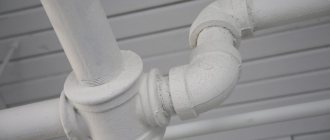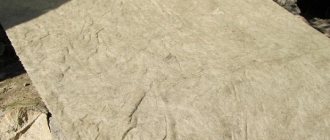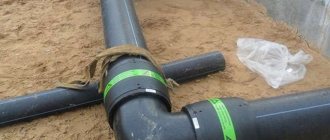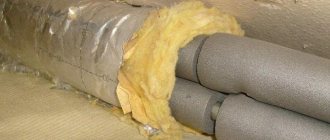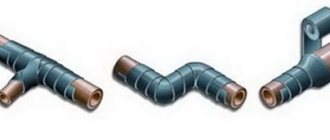There is a huge variety of sealing materials for sealing threads on the modern market. Despite the emergence of innovative analogues, many craftsmen continue to use traditional sanitary linen, which is convenient, reliable and low cost.
Plumbing flax (tow) does not rot for a long time and is a natural material, ideal for use as a winding for pipelines on any metal elements. Plumbing linen has the excellent property of swelling when wet, so a small leak can stop on its own.
In this article we will look at what plumbing tow is, the pros and cons of plumbing flax for sealing threads, as well as how to properly wind flax.
What is sanitary flax (tow)
Plumbing flax (tow) is combed and cleaned flax fibers. This material is intended for sealing metal threads and fittings. Common flax is an annual herbaceous plant. The fiber is produced from the flax stalk. To do this, the plant is first dried. For example, in Egypt, flax is dried directly on the sand under the scorching sun for 15-20 days. Sanitary flax is produced using a special carding machine, after which it is packaged into braids or coils of various lengths.
High-quality flax can be used at temperatures up to 160 degrees in heat and water supply, as well as for steam systems. Does not cause allergies and inhibits bacteria.
Combed sanitary flax
Combed flax has thin, long and strong fibers that fit tightly into the thread and are not destroyed when screwing on the connecting parts. This material is used to seal pipeline and gas connections.
Frayed sanitary linen
Frayed flax is used to produce combed flax and is essentially a raw material. The main difference is that it is coarser and has clogged fibers. Frayed flax is an ideal sealant in the water supply system at the joints of threaded pipes.
Linen differs in quality depending on the degree of purification. There are GOST numbers that correspond to products with a higher or lower degree of purification. The degree of purification of plumbing flax affects the amount of debris and thick plant stems among the threads.
FUM analogues, which is better: flax, tape or liquid sealants
Due to the complex installation technology, many inexperienced craftsmen try to choose an alternative option so as not to use fum tape. The following materials are used as seals at pipe joints:
- tow;
- universal thread;
- liquid FUM (anaerobic sealants).
Each type of material has its own characteristics, advantages and disadvantages, as well as recommended areas of application. Therefore, craftsmen are often concerned about what is better to choose: tow or fum tape, liquid sealant or another option.
In addition to fum tape, there are other materials for sealing threaded connections
Important! Under the influence of ultraviolet radiation, the service life of fluoroplastic products is significantly reduced. Therefore, it is advisable to store reels of tape away from sunlight, in a dry place. Air humidity should not exceed 80%. It is not allowed to store the tape near heating devices, the minimum distance is 1 m.
Should I replace the tape with tow: what is winding and why is it good?
Tow is a natural material based on flax fibers. Designed for sealing steel pipes. It is considered a traditional winding for plumbing systems and, despite the extensive range of more modern materials, is still in high demand among craftsmen.
To determine what is better to take for work: fum tape or flax, it is worth comparing the advantages and disadvantages of these materials. Advantages of sanitary tow:
- the connection is easily adjustable, the fitting can be unscrewed by 45°;
- the material is resistant to mechanical loads;
- high degree of sealing;
- winding over wet or dirty threads is possible;
- due to its ability to absorb moisture, tow swells and blocks minor leaks;
- if necessary, the material can be easily dismantled.
In some cases it is more convenient to use tow
The disadvantages of tow include its susceptibility to rotting. When exposed to moisture, this natural material slowly decomposes.
The scope of application largely depends on what the tow is made from. Plumbing combed flax consists of long, thin fibers that have high strength. They fit tightly and well into the thread. When connecting elements by screwing, the material is not destroyed, so combed flax is best used for gas and pipeline systems.
Torn flax acts as a raw material for the production of combed flax. This material is coarser and its fibers are clogged. It is suitable for sealing threaded connections in water supply systems. Usually tow is preferred by people who do not know how to use fum tape.
In some cases, it is more appropriate to use tape:
- installation of small diameter pipes;
- sealing thin-walled fittings;
- working with plastic pipes.
Thus, to connect a flexible hose to a kitchen faucet, tape is more suitable, and to create a tight connection between a water pipe and a fitting, it is better to use tow.
Helpful advice! It is preferable to use tow when installing pipes with a large diameter. Manufacturers make notches on the threads specifically for this material.
Tow is as easy to wind as fum tape
Characteristics and scope of application of liquid FUM
Liquid FUM consists of methacrylic anaerobic resin. This product cures slowly to securely lock threaded metal connections. It is not afraid of vibrations, remains flexible and is resistant to temperature changes. Unlike tape, sealant perfectly withstands multidirectional loads and fills voids and small gaps well.
Liquid FUM can fully replace tape and tow in systems with different fillings:
- cold and hot water;
- diesel fuel;
- various oils;
- gas (except oxygen);
- almost any chemical compound.
Externally, anaerobic sealant looks like a blue liquid with a viscous consistency. The density of this product is 1.09 g/cm³. There is a slight odor. General characteristics:
- operating temperature - from -55°C to 180°C;
- shelf life - more than 12 months. (at a temperature not exceeding 28°C);
- withstands pressure up to 50 bar;
- afraid of solvents - trichloroethane, acetone.
The use of anaerobic thread sealant in plumbing work
Primary hardening of the material occurs after 2-3 hours; complete hardening requires from 12 to 24 hours.
Note! When oxides or metal particles enter the sealant, an exothermic reaction is triggered - heat is released.
Use Cases
Based on the name, you can understand that plumbing flax is used when connecting elements of water supply, gas pipelines or heating systems. These can be pipes, fittings, taps, various components and much more. However, according to the technical documentation, it can be used for other purposes.
In addition to the professional use of this material, it is also popularly used as environmentally friendly insulation for bathhouses, log houses and houses. Linen does not allow moisture to pass through, retains heat and does not allow air to pass through. There are also rare cases when it is used for sound insulation.
Precautionary measures
- It is not recommended to wind the seal using two or more pieces - this will compromise the tightness and strength of the connection.
- The tape on the thread should not be partially unwound, since if it is applied again, the connection will lose reliability. If winding is unsuccessful, the material should be removed completely and the process repeated.
- If, when connecting the elements, too much tension is created, which can lead to breakage, the tape will not be loosened. In this case, you also need to apply the seal again, removing the old section.
We suggest you familiarize yourself with how long you can store fish in the freezer. FUM tape is a material that is sufficiently reliable when sealing threaded connections. Its correct use will ensure the tightness of any pipeline even for a person who does not have extensive experience in plumbing work.
Advantages of using sanitary linen
Some experts now perceive tow for sealing threads as a material from the last century, but the vast majority successfully use it today. Why does it happen that modern materials are inferior to sanitary flax?
Everything is very simple! Firstly, sanitary tow is an environmentally friendly product, but even despite this, it has many advantages:
- With enough experience in owning tow, you will never see leaks. Occasionally, there are cases when a leak occurs in a cast iron thread where the flax is simply cut off. In other cases, the tow will swell and prevent the threaded connection from leaking;
- Plumbing tow is allowed for products made of both ferrous and non-ferrous metal.
- Plumbing flax is quite resistant to temperature changes. Regardless of the application, flax will not melt or burn out at high temperatures;
- Low cost compared to other sealing materials.
Flaws
Despite all the advantages of using sanitary linen, it also has a number of disadvantages. Their most striking manifestation occurs in the case of improper installation or repair. After short-term use, rust may form, which will create inconvenience during dismantling.
In order to minimize defects as much as possible, we recommend using lubricants such as sealing pastes. Previously, craftsmen used red lead or drying oil for these purposes. Modern plumbing pastes significantly surpass these materials in their characteristics. They are safe for human health and prevent flax rotting and thread corrosion.
Disadvantages, negative points
Despite the large number of advantages, natural sealant is not without its disadvantages. They are especially obvious when installation and repair technology is violated. After short-term use, rust may form at the joints, making it difficult to dismantle structures during subsequent repairs. In view of this, it is recommended to regularly inspect connections for leaks and take measures to eliminate damage.
To minimize shortcomings, it is recommended to use lubricants such as grease, silicone, and sealing pastes.
The material is very sensitive to the quality of work, so it is recommended to use it only by experienced craftsmen.
Attractive physical properties are compensated by the low chemical sensitivity of the material. Thus, flax fibers will be destroyed under the influence of antifreeze if they are part of the mixture passing through connected communications.
There is an opinion that the material is sensitive to high pressure in pipes and, at values exceeding 8 atmospheres, can reduce the quality of sealing. However, the use of plumbing flax for connecting pipes does not lose popularity.
How to wind plumbing flax
The technology for winding sanitary flax (tow) is quite simple and looks like this:
- You must first prepare the surface on which the tow will be wound. If there was already another winding on the thread, then you need to completely clean the area with a metal brush.
- Using pliers, we make notches to better secure the flax during winding. (most modern fittings already have serrations on the threads).
- We take enough plumbing flax to end up with a long thin strand. We wind on the thread.
- It is necessary to wind plumbing flax (tow) onto the thread in the right direction - along the thread. If you have a right-hand thread, you need to wind the tow clockwise; if you are sealing gas connections with a left-hand thread, then the plumbing flax is wound counterclockwise. After the procedure, a special paste is applied to the sanitary linen, for example, from
- Finally, screw the fitting onto the thread, reliably sealing the threaded connection.
Important advice: sometimes, in order to find out how long it is worth screwing a fitting onto a thread, it is better to screw it on without first winding the plumbing flax, while counting the number of thread turns.
Preparatory stage
Before winding flax or tow on the thread, you need to prepare the joint surface and determine the required amount of tow. Screw the fitting onto the thread as is, without wrapping anything. This will help determine how much tow you will need to take.
If the thread is smooth and even (in the case of factory threading, most likely this will be the case), it is recommended to apply notches on the threads for better adhesion. For this, a water wrench, a triangular socket or regular pliers are suitable; all you need to do is apply notches across the thread, without being too zealous. This is done in order to prevent the tow from sliding along the threads.
The notches should not be too deep; you do not need to literally pierce the metal (watch the video). The reliability of the connection in the future will depend on how the tow is wound correctly. If you put too little and rarely, it will leak, but too much can be much more dangerous - a wound area that is wrapped too tightly can burst when the temperature rises (as you know, metal expands when heated).
Order plumbing linen wholesale
carries out wholesale and retail trade, and is also a manufacturer of sanitary flax (tow), supplied to private plumbing stores and large DIY stores. We provide a detailed price list for the entire range, have ample options for payment and delivery, and also provide advice on any issue. Over the years, we have established partnerships with many stores and suppliers.
Our specialists will help you organize your own business and select the necessary products.
Still have questions? Call or write - we will answer. Phone: +7 E-mail Address: St. Petersburg, st. Zastavskaya, 5/1.


